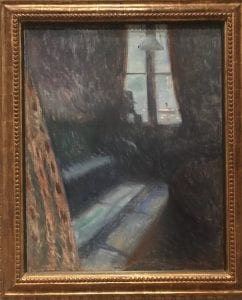Night in Saint-Cloud was painted by Edvard Munch, a Norwegian Expressionist painter, in 1893 using oil on canvas. In Night in Saint-Cloud, a lone figure sits by a window overlooking the city. Edvard Munch paints the figure as a dark silhouette. However, from its shape, the viewer can see that the figure wears a top hat and is sitting hunched with his head propped up by his hand, which rests on the window. There is a soft highlight on the figure’s leg, giving it some dimension. The main light source of the room is the window, lit by the distant city and the moonlight. A single, unlit light hangs above the man and the window’s frame casts a long shadow on the floor. Munch utilizes cool colors like blue, green and purple for the majority of the painting. He uses warmer tones for the city lights and what appears to be the pattern of either a curtain or a piece of furniture painted in the bottom left corner. The pattern is made up of green stripes and red spots on a light yellow-brown base. A red or orange can also be seen in the shadows. The texture of the painting is brushy, each brush stroke is visible to the viewer. Edvard Munch’s use of composition, pose and color contributes to the overall mood of the painting.
Edvard Munch’s painting, Night in Saint-Cloud emanates a feeling of melancholy or loneliness. The way the patterned furniture or curtain is positioned to the left of the painting makes the audience feel as if they are looking or intruding on a private moment experienced by the silhouetted figure, which is painted in the very center of the piece. Except for the couch the figure is sitting on and what seems to be a round table to the right, there aren’t many other pieces of furniture visible in the room. The right corner of the painting is engulfed in shadow. This allows the main focal point of the painting to be the figure and the window, giving the room a feeling of emptiness and adding to the sense of loneliness. Additionally, the pose of the figure is calm and pensive. He sits with his back arched forward and his head resting on his hand. From the way the body is positioned, one can see that the figure is staring out the window at the city. His pose raises a question: what is he thinking about? It seems like an hour of self-reflection. Finally, Munch’s use of color also adds to the mood of the painting. The color blue has been associated with the feeling of calmness or sadness. He uses a range of blues and hints of green and purple in the center of the painting. To the left and the right, Munch includes warmer tones. Like his composition, his use of warm colors also frames the main focus of the painting.
Through his use of composition, pose, and color, Edvard Munch creates a melancholy and intimate moment. According to the description displayed beside the painting, a Danish poet named Emanuel Goldstein modeled for this painting. Additionally, this painting may be related to his father’s death or another personal experience. Munch had painted several versions of night time window scenes using different mediums. The way he sets up the composition of this painting makes the viewer feel as though they are watching the figure from afar. The patterned furniture or curtain in the left and the dark shadow in the right frames the main subject. The pose of the figure is calm and reflective as he hunches forward staring out at the far away city with his head in his hand. The colors Munch uses in the center of the painting is cool. They are predominantly different shades of blue. Blue has long been thought of as a tranquil and melancholy color. Through his use of all of these techniques, Edvard Munch paints a piece that is filled with emotion.
Munch, Edvard. Night in Saint-Cloud. 1893. Metropolitan Museum of Art.
